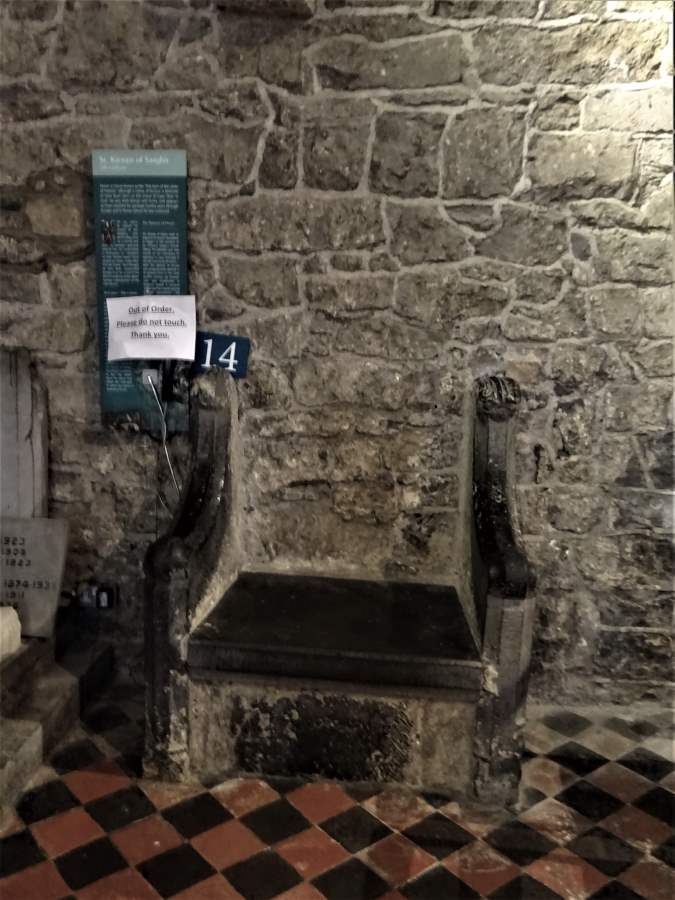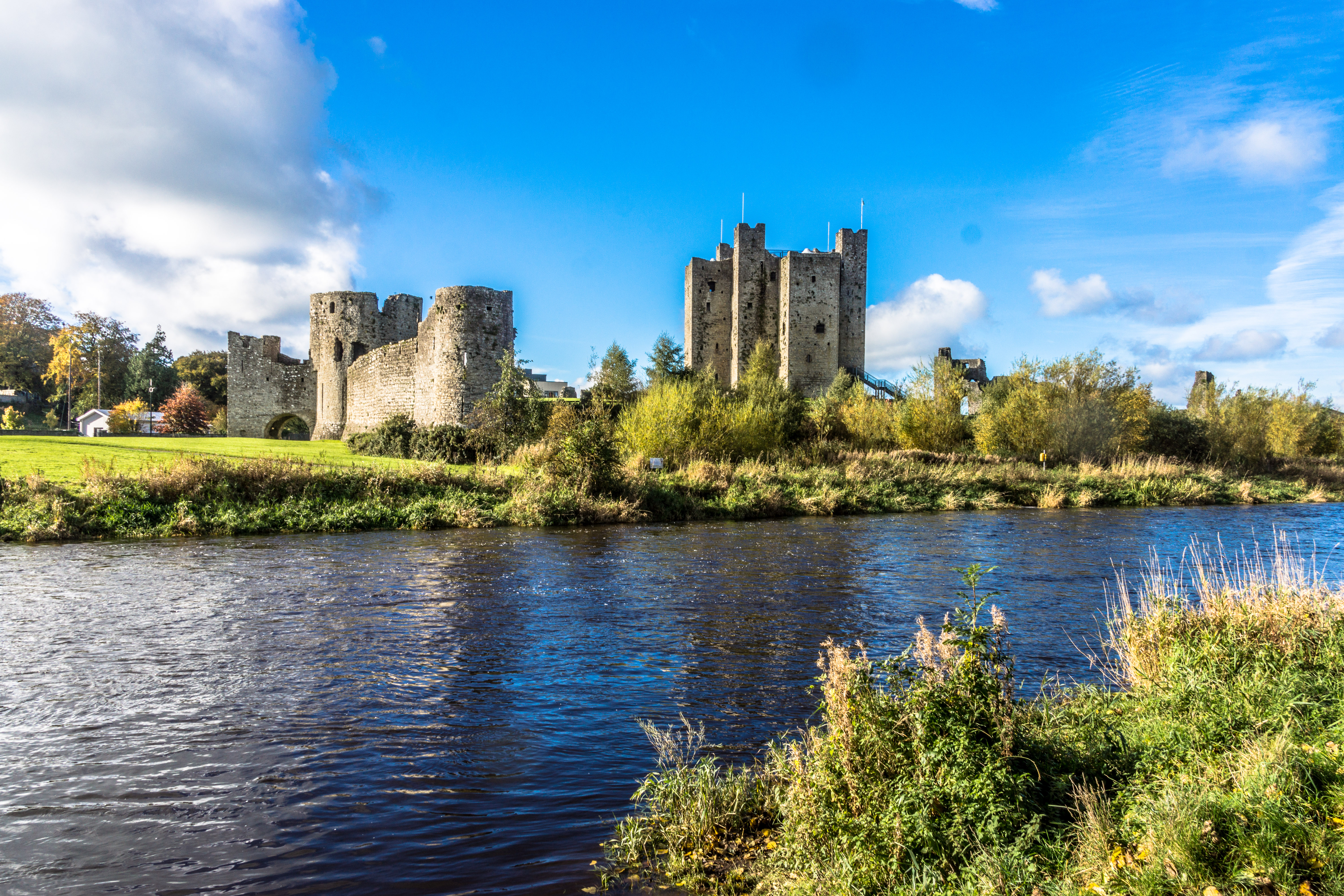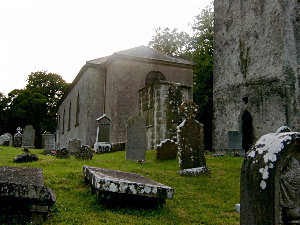|
Alexander De Balscot
Alexander de Balscot, also known as Alexander Petit (died 1400) was one of the leading Irish clerics of the late fourteenth century, who held the offices of Bishop of Ossory, Bishop of Meath, Treasurer of Ireland and Lord Chancellor of Ireland. He was born at Balscote in Oxfordshire; Nicholas de Balscote, Chief Baron of the Irish Exchequer 1313-1319, was probably his cousin, though of an earlier generation. John Balscot, Deputy to the Lord Treasurer of Ireland in 1354, may also have been a relative. Alexander is first heard of in Ireland in 1358; he became vicar of Dungarvan in 1359, Bishop of Ossory in 1371 and Bishop of Meath in 1386. He was criticised for spending large sums of money to influence his election to the See of Ossory but received a royal pardon to cover any possible wrongdoing. He was appointed Treasurer of Ireland in 1372 and again in 1376-7; he acted as Justiciar of Ireland in 1379. Richard II appointed him Lord Chancellor in 1386. He was a key member o ... [...More Info...] [...Related Items...] OR: [Wikipedia] [Google] [Baidu] |
Bishop Of Ossory
The Bishop of Ossory () is an Episcopal polity, episcopal title which takes its name after the ancient of Kingdom of Ossory in the Provinces of Ireland, Province of Leinster, Republic of Ireland, Ireland. In the Roman Catholic Church it remains a separate title, but in the Church of Ireland it has been united with other bishoprics. History The diocese of Ossory was one of the twenty-four dioceses established at the Synod of Rathbreasail in 1111 and coincided with the ancient Kingdom of Ossory (Osraige); this is unusual, as Christian dioceses are almost always named for cities, not for regions. The episcopal see has always been in Kilkenny, the capital of Ossory at the time of the Synod of Rathbreasail. The erroneous belief that the cathedral was originally further north at Aghaboe is traced by John Bradley to a 16th-century misinterpretation of a 13th-century property transfer, combined with the fact that the abbey at the site which became St Canice's Cathedral, Kilkenny, was ... [...More Info...] [...Related Items...] OR: [Wikipedia] [Google] [Baidu] |
Battle Of Radcot Bridge
The Battle of Radcot Bridge was fought on 19 December 1387 in medieval England between troops loyal to Richard II, led by court favourite Robert de Vere, and an army captained by Henry Bolingbroke, Earl of Derby. It took place at Radcot Bridge, a bridge over the River Thames, now in Oxfordshire, but then the boundary between Oxfordshire and Berkshire. Background The previous year had seen increasing hostility between the young King Richard II and his magnates. This crisis reached a head in November 1386, when the Wonderful Parliament compelled King Richard to remove his chancellor, Michael de la Pole. According to the 16th-century chronicler Raphael Holinshed: In the words of a modern English historian: On Saturday 22 September 1397 Sir Thomas Mortimer was summoned to stand trial as a traitor. Mortimer's alleged crime was the slaying of Thomas Molineux, constable of Chester Castle, at the skirmish at Radcot Bridge in 1387. Molineux had been one of the most important Ro ... [...More Info...] [...Related Items...] OR: [Wikipedia] [Google] [Baidu] |
1400 Deaths
Fourteen or 14 may refer to: * 14 (number), the natural number following 13 and preceding 15 * one of the years 14 BC, AD 14, 1914, 2014 Music * 14th (band), a British electronic music duo * ''14'' (David Garrett album), 2013 *''14'', an unreleased album by Charli XCX * "14" (song), 2007, from ''Courage'' by Paula Cole Other uses * ''Fourteen'' (film), a 2019 American film directed by Dan Sallitt * ''Fourteen'' (play), a 1919 play by Alice Gerstenberg * ''Fourteen'' (manga), a 1990 manga series by Kazuo Umezu * ''14'' (novel), a 2013 science fiction novel by Peter Clines * ''The 14'', a 1973 British drama film directed by David Hemmings * Fourteen, West Virginia, United States, an unincorporated community * Lot Fourteen, redevelopment site in Adelaide, South Australia, previously occupied by the Royal Adelaide Hospital * "The Fourteen", a nickname for NASA Astronaut Group 3 * Fourteen Words, a phrase used by white supremacists and Nazis See also * 1/4 (other) * Fo ... [...More Info...] [...Related Items...] OR: [Wikipedia] [Google] [Baidu] |
Year Of Birth Unknown
A year or annus is the orbital period of a planetary body, for example, the Earth, moving in its orbit around the Sun. Due to the Earth's axial tilt, the course of a year sees the passing of the seasons, marked by change in weather, the hours of daylight, and, consequently, vegetation and soil fertility. In temperate and subpolar regions around the planet, four seasons are generally recognized: spring, summer, autumn and winter. In tropical and subtropical regions, several geographical sectors do not present defined seasons; but in the seasonal tropics, the annual wet and dry seasons are recognized and tracked. A calendar year is an approximation of the number of days of the Earth's orbital period, as counted in a given calendar. The Gregorian calendar, or modern calendar, presents its calendar year to be either a common year of 365 days or a leap year of 366 days, as do the Julian calendars. For the Gregorian calendar, the average length of the calendar year ( ... [...More Info...] [...Related Items...] OR: [Wikipedia] [Google] [Baidu] |
People From Oxfordshire
A person ( : people) is a being that has certain capacities or attributes such as reason, morality, consciousness or self-consciousness, and being a part of a culturally established form of social relations such as kinship, ownership of property, or legal responsibility. The defining features of personhood and, consequently, what makes a person count as a person, differ widely among cultures and contexts. In addition to the question of personhood, of what makes a being count as a person to begin with, there are further questions about personal identity and self: both about what makes any particular person that particular person instead of another, and about what makes a person at one time the same person as they were or will be at another time despite any intervening changes. The plural form "people" is often used to refer to an entire nation or ethnic group (as in "a people"), and this was the original meaning of the word; it subsequently acquired its use as a plural form of per ... [...More Info...] [...Related Items...] OR: [Wikipedia] [Google] [Baidu] |
Lord Chancellors Of Ireland
The Lord High Chancellor of Ireland (commonly known as Lord Chancellor of Ireland) was the highest judicial office in Ireland until the establishment of the Irish Free State in 1922. From 1721 to 1801, it was also the highest political office of the Irish Parliament: the Chancellor was Speaker of the Irish House of Lords. The Lord Chancellor was also Lord Keeper of the Great Seal of Ireland. In all three respects, the office mirrored the Lord High Chancellor of Great Britain. Origins There is a good deal of confusion as to precisely when the office originated. Until the reign of Henry III of England, it is doubtful if the offices of Irish and English Chancellor were distinct. Only in 1232 is there a clear reference to a separate Court of Chancery (Ireland). Early Irish Lord Chancellors, beginning with Stephen Ridell in 1186, were simply the English Chancellor acting through a Deputy. In about 1244 the decision was taken that there must be separate holders of the office in England ... [...More Info...] [...Related Items...] OR: [Wikipedia] [Google] [Baidu] |
14th-century Irish Judges
As a means of recording the passage of time, the 14th century was a century lasting from 1 January 1301 ( MCCCI), to 31 December 1400 ( MCD). It is estimated that the century witnessed the death of more than 45 million lives from political and natural disasters in both Europe and the Mongol Empire. West Africa experienced economic growth and prosperity. In Europe, the Black Death claimed 25 million lives wiping out one third of the European population while the Kingdom of England and the Kingdom of France fought in the protracted Hundred Years' War after the death of Charles IV, King of France led to a claim to the French throne by Edward III, King of England. This period is considered the height of chivalry and marks the beginning of strong separate identities for both England and France as well as the foundation of the Italian Renaissance and Ottoman Empire. In Asia, Tamerlane (Timur), established the Timurid Empire, history's third largest empire to have been ever esta ... [...More Info...] [...Related Items...] OR: [Wikipedia] [Google] [Baidu] |
Trim, County Meath
Trim () is a town in County Meath, Ireland. It is situated on the River Boyne and has a population of 9,194. The town is noted for Trim Castle – the largest Norman castle in Ireland. One of the two cathedrals of the United Dioceses of Meath and Kildare — St Patrick's cathedral — is located north of the river. Trim won the Irish Tidy Towns Competition in 1972, 1984, 2014 and 2022, and was the "joint" winner with Ballyconnell in 1974. Trim was historically the county town of Meath, but this title was passed on in 1898 to the larger, neighbouring town of Navan. History Early history At an early date, a monastery was founded at Trim, which lay within the petty kingdom ('' tuath'') of the Cenél Lóegairi. It is traditionally thought to have been founded by St. Patrick and left in the care of its patron saint Lommán, also locally known as Loman, who flourished sometime between the 5th and early 6th centuries.Stalmans and Charles-Edwards, "Meath, saints of (act. ''c''.4 ... [...More Info...] [...Related Items...] OR: [Wikipedia] [Google] [Baidu] |
County Meath
County Meath (; gle, Contae na Mí or simply ) is a Counties of Ireland, county in the Eastern and Midland Region of Republic of Ireland, Ireland, within the Provinces of Ireland, province of Leinster. It is bordered by County Dublin, Dublin to the southeast, County Louth, Louth to the northeast, County Kildare, Kildare to the south, Offaly to the southwest, Westmeath to the west, County Cavan, Cavan to the northwest, and County Monaghan, Monaghan to the north. To the east, Meath also borders the Irish Sea along a narrow strip between the rivers River Boyne, Boyne and Delvin River, Delvin, giving it the List of Irish counties by coastline, second shortest coastline of any county. Meath County Council is the Local government in the Republic of Ireland, local authority for the county. Meath is the List of Irish counties by area, 14th-largest of Ireland's 32 traditional counties by land area, and the List of Irish counties by population, 8th-most populous, with a total population o ... [...More Info...] [...Related Items...] OR: [Wikipedia] [Google] [Baidu] |
Ardbraccan
Ardbraccan ( ga, Ard Breacáin) is an ancient place of Christian worship in County Meath, Ireland. It is the location of the former residence of the Roman Catholic, then, after the Reformation, the Church of Ireland Bishop of Meath. It is approximately 30 miles (48 kilometres) from Dublin. Origins Ardbraccan originated as a place of Christian worship under ''St Breacain'' (also spelt ''St Braccan'' - d.650 AD ) in the 7th century. Its name in the Irish language comes directly from the saint's name: ''Ard Breacain'', meaning the height or Hill of Braccan. On this high point, a monastery and a succession of churches were built, each larger than the last to accommodate the growing number of religious worshippers. The most famous was a large circular church known as the ''Daimhliag'' ("stone house"), which was burned to the ground by Viking attackers in the 12th century. Contemporary records say that one thousand people were in the church, seeking protection from the invaders, at th ... [...More Info...] [...Related Items...] OR: [Wikipedia] [Google] [Baidu] |
Lord High Treasurer Of Ireland
The Lord High Treasurer of Ireland was the head of the Exchequer of Ireland, chief financial officer of the Kingdom of Ireland. The designation ''High'' was added in 1695. After the Acts of Union 1800 created the United Kingdom of Great Britain and Ireland, the Consolidated Fund Act 1816 merged the Irish Inferior Exchequer into the British Treasury with effect from 1817. The act also mandated that the post of Lord High Treasurer of Ireland could only be held together with the post of Treasurer of the Exchequer, with the person holding both being Lord High Treasurer. If no person is appointed to the combined positions, then the Lord High Treasurer of Ireland is placed in commission and represented by the Lords Commissioners of the Treasury, as has been the case continuously since 1816. The Superior Irish Exchequer, or Court of Exchequer, remained, led by the Chief Baron of the Irish Exchequer. Lord Treasurers of Ireland 1217–1695 *1217–1232: John de St John, Bishop of Fern ... [...More Info...] [...Related Items...] OR: [Wikipedia] [Google] [Baidu] |
Robert Crull
Sir Robert Crull (1349–1408) was the Treasurer of Ireland during the reigns of Richard II and Henry IV. Crull is an important figure in the history of English Ireland during the reign of Richard II (1382–1399) for two reasons: his involvement in the antagonism between the Geraldine and Butler families at its most notorious stage, and being at times a sacrificial lamb in Richard II's power struggle with the English Parliament over the stormy colonial politics that ensued. Crull had been prebendary of Swords, and had been asked by the English colonial community to go to Westminster in 1385 to transact business relating to the problems caused by the falling-out between the then English Lord Lieutenant of Ireland, Sir Philip Courtenay, and his appointed Chief Governor of Ireland James Butler, 3rd Earl of Ormond. Crull had been a protégé of Ormond and Bishop Alexander de Balscot. All three joined Robert de Vere, the Earl of Oxford and newly appointed Marquess of Dublin and Du ... [...More Info...] [...Related Items...] OR: [Wikipedia] [Google] [Baidu] |


_1938.jpg)



